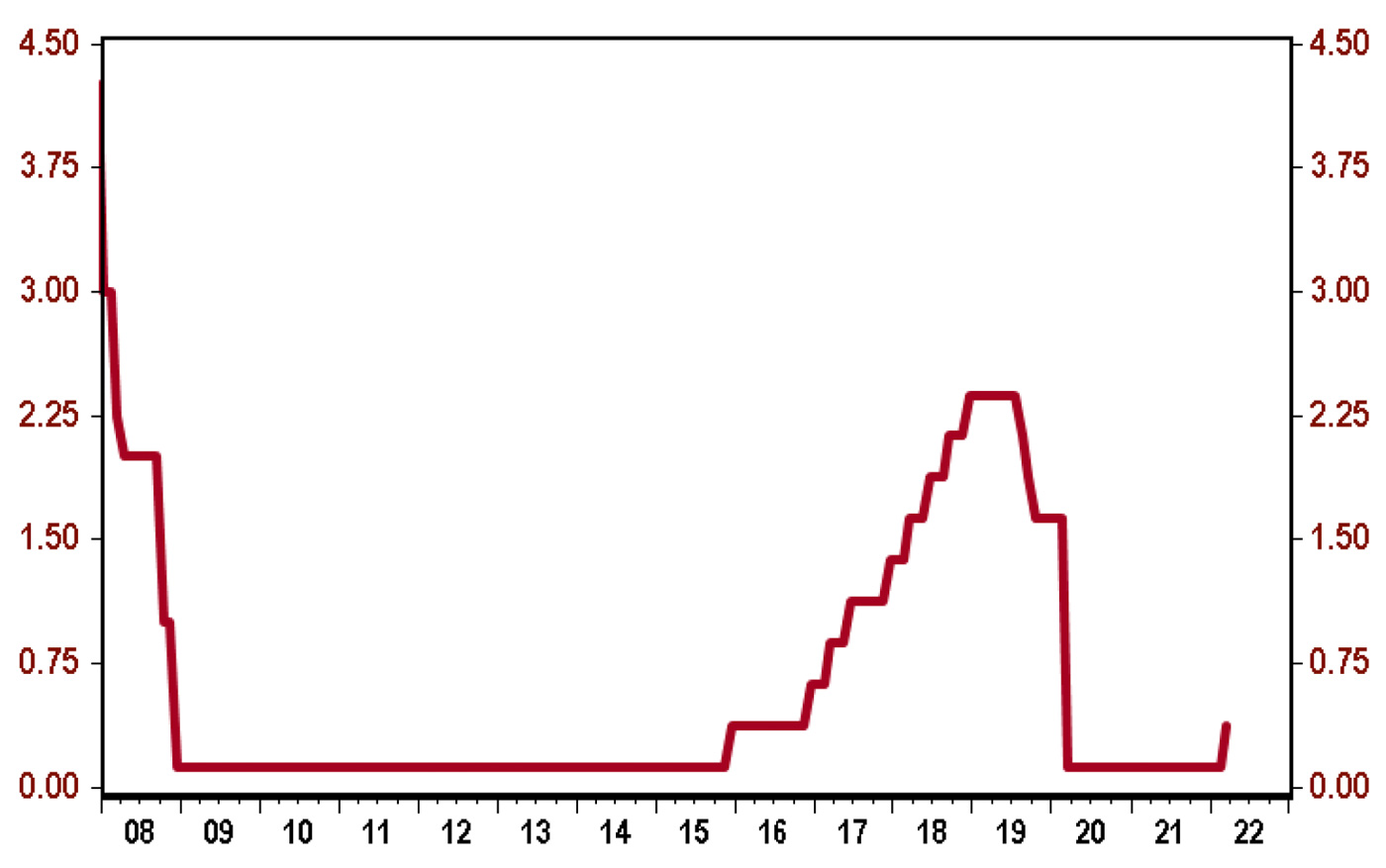

As expected, the Federal Reserve raised short-term rates by one-quarter of a percentage point (25 basis points) last week, the first rate hike since the end of 2018. Even more important, the Fed signaled a new level of hawkishness in terms of future rate hikes as well as quantitative tightening (QT).
FED FUNDS TARGET RATE (%)

Sources: Federal Reserve Board, Haver Analytics
The “dot plot,” which shows the pace of rate hikes anticipated by policymakers, suggests the median Fed official thinks short-term rates will go up 1.75 percentage points this year, which would be consistent with 25-basis-point rate hikes at every meeting for the remainder of the year. This would also be consistent with the new language in the Fed’s statement that it anticipates rate hikes will be “ongoing.” Notably, this would also mean the Fed is prepared to continue raising rates through the midterm election season without pausing.
In addition, the median “dot” suggests another 75–100 basis points in rate hikes in 2023, which would take short-term rates to a peak of about 2.75%. That, in turn, is slightly above the median estimate for the average short-term rate over the long run. In other words, the Fed now thinks it’ll overshoot on rates, although not by much.
But the Fed didn’t only change policy on rate hikes. It also shifted to an earlier timing on quantitative tightening by saying it “expects to begin reducing [its balance sheet] at a coming meeting.” It looks like the Fed will start QT in May unless the economy runs into some unexpected headwinds. Notably, Powell said at the press conference that QT will be faster than it was back in 2018–2019. The fastest pace in that cycle was $50 billion per month. Look for a pace of around $75–$100 billion per month in this cycle.
The dramatic turn in the projected pace of rate hikes and the earlier schedule for QT was accompanied by some big changes to the forecast for the economy this year. Expected real GDP growth was downgraded to 2.8% from 4.0%, while expected PCE (personal consumption expenditures) inflation was lifted to 4.3% from a prior estimate of 2.6%. However, the real GDP growth forecast for 2023 and beyond wasn’t changed, and the upward revisions to the inflation forecast for 2023–2024 were modest.
Is the Fed worried that removing accommodation will cause a recession? Not yet. At the post-meeting press conference, Powell said that the odds of a recession are not “elevated” over the next year and the economy can “flourish” even as the Fed becomes less accommodative. Powell thinks he can engineer a “soft landing.” We will see. He is likely right about 2022 itself. A federal funds rate below 2.0% is not tight. But wrestling inflation down to 2.0% is going to be tough to do without the Fed eventually getting tight enough to cause a recession.
This does not mean it’s time to get bearish on equities. Economic growth continues, corporate profits are very high, and long-term interest rates—although they’ve moved up recently—are still low enough to make equities relatively attractive. In a better world, the Fed would operate in the background and investors could ignore it. Unfortunately, for the time being, investors are going to have to pay attention to the direction and pace of changes to monetary policy.
We believe today’s policy shifts are long overdue. Consumer prices rose 7.0% last year, and the year-ago comparison should peak near 9.0% sometime in the next month or so. The Fed is well behind the curve and has its work cut out for it.
Editor’s note: Brian Wesbury is chief economist at First Trust Advisors LP. He and his team prepare a weekly market commentary titled “Monday Morning Outlook,” as well as frequent research reports. Proactive Advisor Magazine thanks First Trust for permission to republish an edited version of this commentary, which was first published on Mar. 16, 2022.
The opinions expressed in this article are those of the author and do not necessarily represent the views of Proactive Advisor Magazine. These opinions are presented for educational purposes only.
New this week:
First Trust Portfolios LP and its affiliate First Trust Advisors LP (collectively “First Trust”) were established in 1991 with a mission to offer trusted investment products and advisory services. The firms provide a variety of financial solutions, including UITs, ETFs, CEFs, SMAs, and portfolios for variable annuities and mutual funds. www.ftportfolios.com
